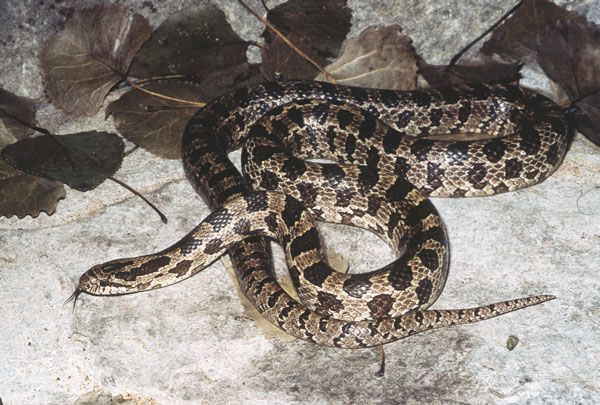Description:
Prairie kingsnakes use a typical colubrid setup. A 10-gallon tank will easily house a hatchling up to 2 years old. You can use a bit more roomy enclosure for larger adults. A 40-gallon tank can easily house two of them. Bedding that works well is aspen or pine bark. These snakes like to burrow, so a couple inches of substrate would be ideal. Place a heating pad at one end to create a hotspot of about 90 degrees Fahrenheit. The cool end should be about 75 degrees. Place a bowl large enough for the snake to drink from at the cool end. Change out the water daily. This species needs secure hiding place, which can be cork bark, commercial plastic hides, old plant pots, an old shoe, just about anything. Make sure you have a very secure top, as these snakes can and will wonder off if given the chance. No lighting is required. Prairie kingsnakes will readily accept thawed mice. Large adults will feed on large mice. Be aware that they will also eat small birds, lizards and other snakes. When housing two of these snakes together, be cautious. They should be around the same size. Cannibalism in this species is not common, but it does happen. At least one mouse every week is a good feeding schedule. Although field-collected prairie kings are found for sale, this species is being captive bred so commonly now that taking specimens from the wild is uncalled for. They are easy to breed and the captive-bred snakes make hardy, easy-to-keep pets. They grow quickly if fed properly. There is also an albino morph commonly found on the market, sometimes more so then the normal-colored ones. They are inexpensive snakes, and they can be found in pet stores, reptile specialty stores, on the Internet and at reptile shows. Easy to keep and beautiful in color, whether normal or albino, this hardy snake gets big, but not too big. They are usually very mellow and a great snake for kids. I recommend this species for the beginner or experienced herpkeeper. Ken Foose produced his first captive-bred snakes at age 11. With a Master’s Degree in zoology, he has been both a zookeeper and curator. He opened Exotic Pets, which specializes in reptiles and amphibians, in Las Vegas in 1991. He is currently president of the International Herpetological Symposium.
Habitat:
Open areas, bordering forests, in loose dirt or sandy places. Actually found on the beach under driftwood in some areas along the Texas coast. Prairie kingsnakes tend to live near permanent bodies of water like creeks, rivers, ponds, lakes and old wells.
Range:
Midwest United States, from Nebraska south to southern Texas
Scientific Name: Lampropeltis calligaster calligaster
Species Group: kingsnake
Family: Colubridae
Size: more-than-20-years
Level: intermediate
Weight:
Dangerous: No



